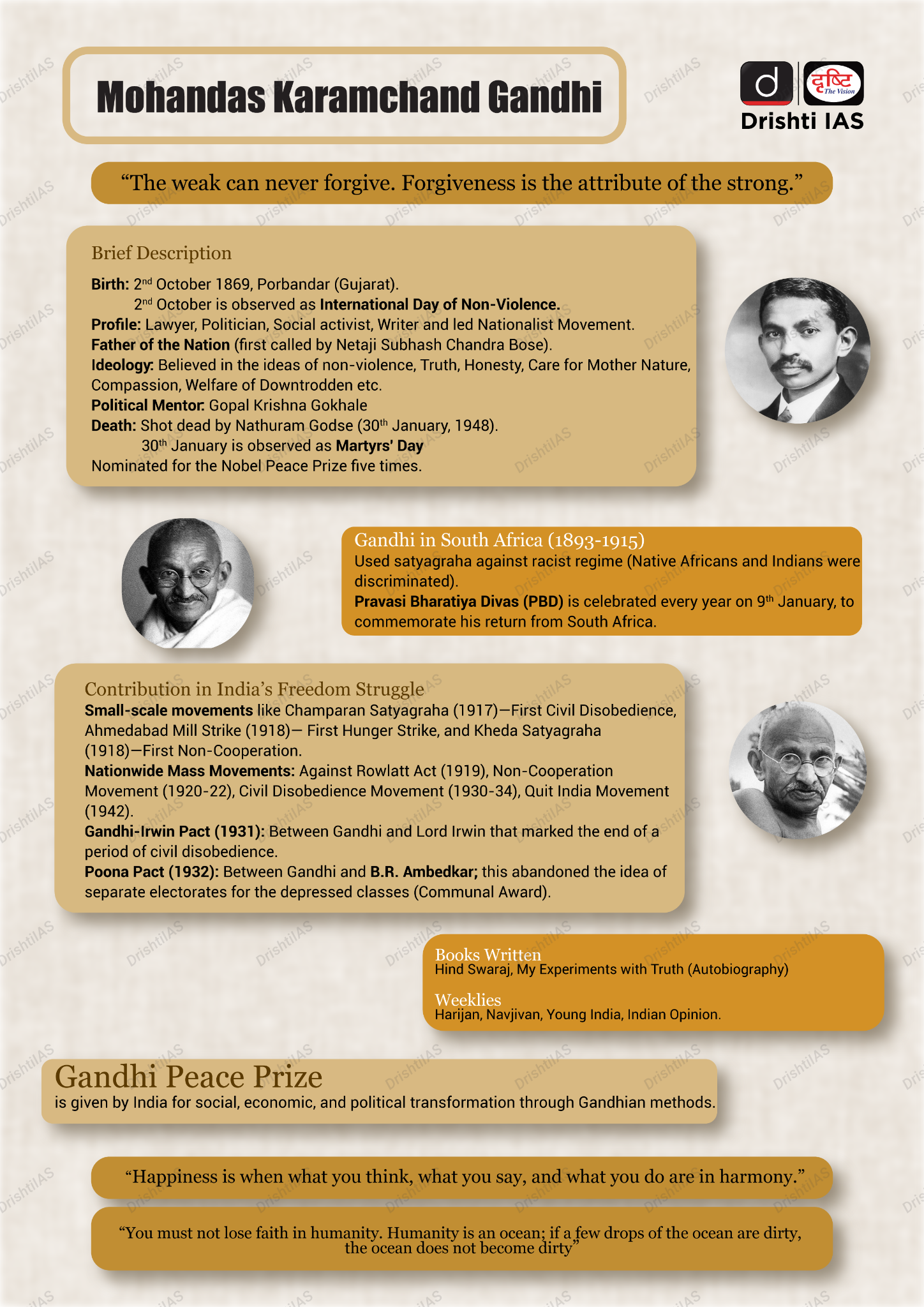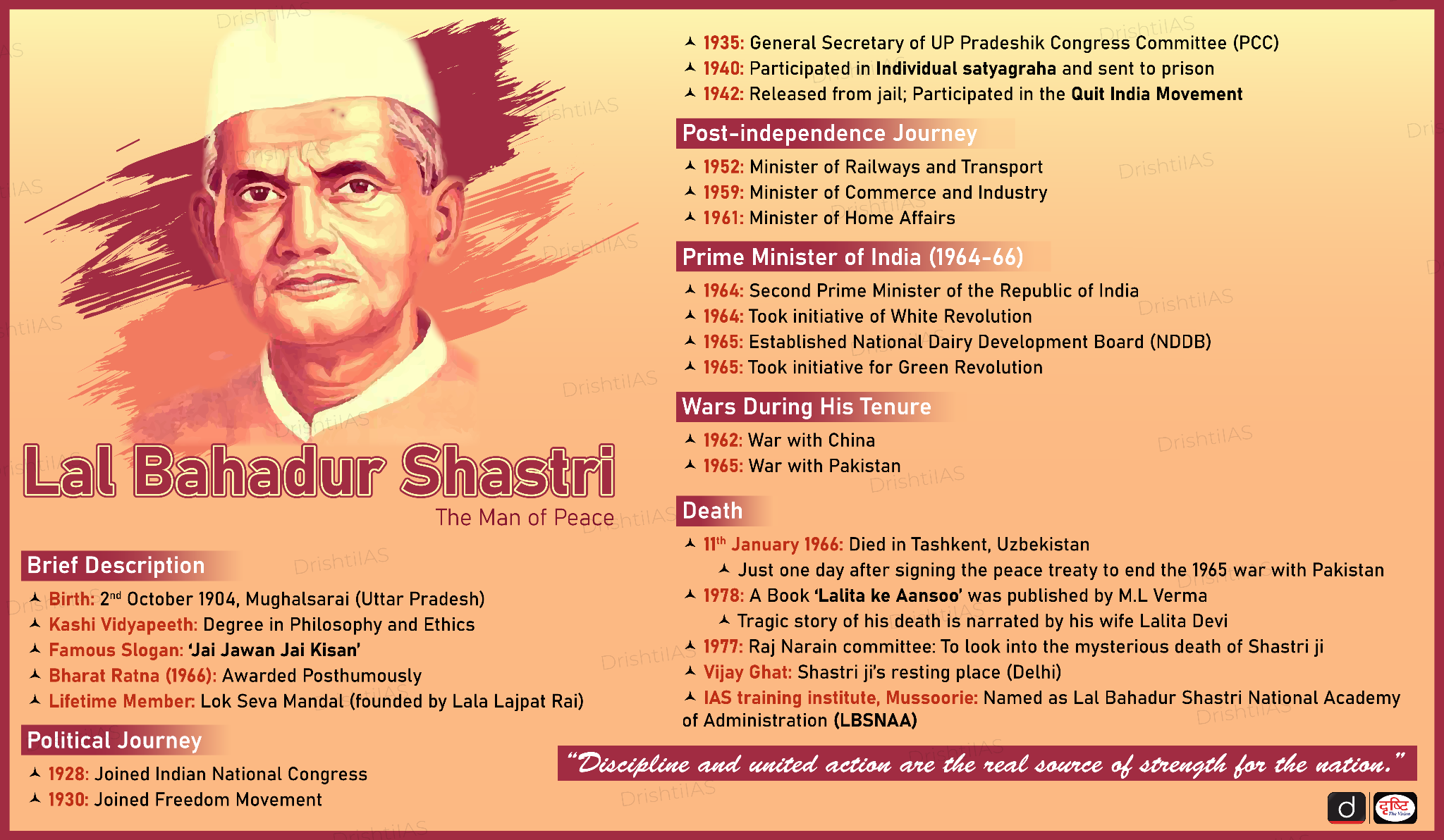Birth Anniversary of Mahatma Gandhi and Shri Lal Bahadur Shastri | 03 Oct 2025
Why in News?
Prime Minister of India paid tributes to Mahatma Gandhi and Shri Lal Bahadur Shastri on their birth anniversaries, recalling their invaluable contributions to India’s freedom, integrity, and nation-building.
Mahatma Gandhi
- Early Life: Born on 2nd October 1869 at Porbandar, Gandhi married Kasturbai in 1882 and studied law in England (1888–91). His legal career soon merged with his moral quest for justice.
- Experiences in South Africa: In 1893, racial humiliation at Pietermaritzburg shaped his resolve against injustice.
- He founded the Natal Indian Congress (1894), launched the newspaper Indian Opinion, established Phoenix Settlement (1904) and Tolstoy Farm (1910) where he evolved Satyagraha as non-violent resistance.
- Return to India: Gandhi returned on 9th January 1915 (now celebrated as Pravasi Bharatiya Diwas) and set up Sabarmati Ashram (1917). He rooted his politics in simplicity, truth, and self-reliance.
- Major Movements: His leadership shone in Champaran Satyagraha (1917), Kheda Kheda Satyagraha (1918), and the Rowlatt Satyagraha (1919). Later, he guided the nation through the Non-Cooperation Movement (1920–22), the Civil Disobedience Movement with Dandi March (1930), and the Quit India Movement (1942).
- Writings & Ideas: Gandhi articulated his vision in Hind Swarajya and his Autobiography titled "An Autobiography: The Story of My Experiments with Truth".
- He promoted Khadi and the Charkha as tools of self-reliance and dignity of labour, and established institutions like the All India Spinners’ Association (1925) and the Harijan Sevak Sangh (1932) to further social and economic reform.
- Legacy: Gandhi’s last years were devoted to communal harmony and upliftment of Harijans. He was assassinated on 30th January 1948.
- Gandhi revered as the “Father of the Nation,” his legacy of truth and non-violence remains globally relevant.
- 2nd October is celebrated as Gandhi Jayanti and globally as the International Day of Non-Violence, as declared by the United Nations.
Gandhian Philosophy in Contemporary Initiatives
|
Initiative |
Gandhian Philosophy |
|
Cleanliness is next to godliness |
|
|
Cooperative economics & grassroots empowerment |
|
|
Swadeshi & village-based production |
|
|
Village self-reliance & Panchayati Raj |
|
|
Tribal advancement for national development |
|
|
Right to dignified work & inclusive development |
Shri Lal Bahadur Shastri
- Early Life: Lal Bahadur Shastri was born on 2nd October 1904 at Mughalsarai, Uttar Pradesh. He was deeply inspired by Mahatma Gandhi’s Non-Cooperation Movement (1920).
- Studied at Kashi Vidyapeeth, Varanasi, where he earned the title “Shastri,” which later became part of his name.
- Role in Freedom Struggle: Actively participated in Civil Disobedience Movement and got arrested multiple times he spent over seven years in British jails.
- Political Career Post-Independence: Became Parliamentary Secretary in Uttar Pradesh (1946), later rising to Home Minister of the state. Later held important Union portfolios (Railways, Transport & Communications, Commerce & Industry, Home Affairs).
- He is well known for resigning as Railway Minister (1956) taking moral responsibility for a train accident, a rare act of political accountability.
- Leadership Qualities: Admired for integrity, humility, and efficiency, earning the title “little dynamo of a man.”
- Prime Ministership: Lal Bahadur Shastri succeeded Jawaharlal Nehru as Prime Minister.
- As Prime Minister (1964–66), Shastri showed firm leadership in the 1965 Indo-Pak war. His enduring legacy lies in the slogan “Jai Jawan, Jai Kisan,” highlighting the twin pillars of national security and food security.
- Shastri died suddenly in Tashkent on 11th January 1966, shortly after signing the Tashkent Declaration.
Frequently Asked Questions (FAQs)
1. When is the International Day of Non-Violence observed and why?
It is observed on 2nd October, Mahatma Gandhi’s birth anniversary, as declared by the UN in 2007, to spread Gandhian ideals of peace and non-violence.
2. Which was Mahatma Gandhi’s first successful Satyagraha in India?
The Champaran Satyagraha (1917), addressing indigo farmers’ exploitation in Bihar.
3. What was Lal Bahadur Shastri’s famous slogan and its significance?
“Jai Jawan, Jai Kisan” (1965), highlighting the twin pillars of national defense and food security.
UPSC Civil Services Examination, Previous Year Questions (PYQs)
Prelims
Q. Who among the following is associated with ‘Songs from Prison’, a translation of ancient India religious lyrics in English? (2021)
A. Bal Gangadhar Tilak
B. Jawaharlal Nehru
C. Mohandas Karamchand Gandhi
D. Sarojini Naidu
Ans: C
Q: With reference to the British colonial rule in India, consider the following statements: ( 2019)
- Mahatma Gandhi was instrumental in the abolition of the system of ‘indentured labour’.
- In Lord Chelmsford’s ‘War Conference’, Mahatma Gandhi did not support the resolution on recruiting Indians for World War.
- Consequent upon the breaking of the Salt Law by the Indian people, the Indian National Congress was declared illegal by the colonial rulers.
Which of the statements given above are correct?
A. 1 and 2 only
B. 1 and 3 only
C. 2 and 3 only
D. 1, 2 and 3
Ans: B


